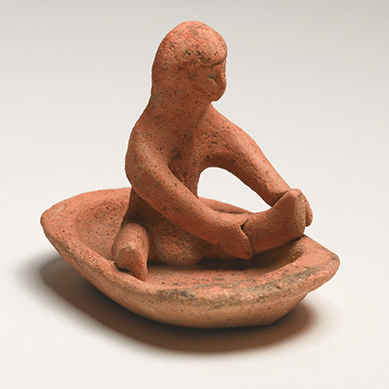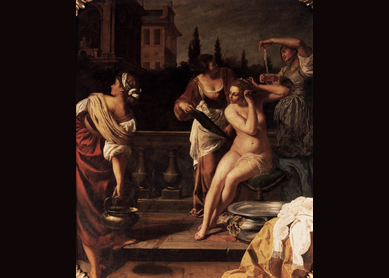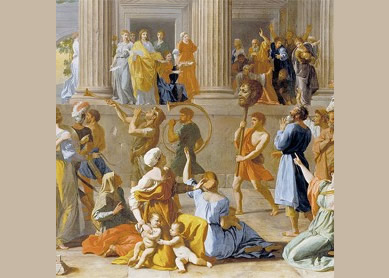Bathsheba’s relatively short story is packed with scandal and intrigue. Bathsheba is bathing when David first sees her. Despite her being married, David sends for Bathsheba and has sex with her. She becomes pregnant, and after other attempts to cover up his misconduct, David commands that her husband Uriah be killed in battle. Bathsheba becomes David’s wife and bears his son. But Nathan the prophet confronts David about his sins, and God punishes David through the death of Bathsheba’s child. Bathsheba and David have a second child, Solomon, who succeeds his father as king, though he is not the oldest living son. The lack of details in Bathsheba’s story has resulted in her character being read in multiple ways.
Why is Bathsheba interpreted in such different ways?
The chapters where Bathsheba appears are especially terse, even for biblical Hebrew narrative. Particularly in 2 Samuel, Bathsheba’s motives and emotions go undescribed when certain actions are narrated. The gaps in the text have been filled by interpreters who characterize her on the spectrum from passive victim to active seductress.
Bathsheba’s first action is bathing, and many have understood her bath to be some sort of exhibitionist act to tempt and seduce David. In songs and art, Bathsheba bathes “on the roof” or naked in the open air. Second, 2Sam 11:4 says that Bathsheba comes to David when summoned. Those details could be related, Bathsheba bathing in the hopes that David would see her and send for her. Bathsheba’s third action in 2Sam 11 is to send a message to David announcing her pregnancy. Perhaps she wanted to have his child and be his queen. In 2Sam 11:26, Bathsheba laments Uriah’s death, but maybe those are crocodile tears.
Each one of these actions, however, can be read differently. The text specifies that her bath was an obligatory act of purification and clarifies that David—not Bathsheba—was on the roof. The story is set during the spring, when kings are at war, and even if Bathsheba were in a place in the line of sight of the palace, she could have expected that David was away (as was her husband, a soldier in David’s army). In the early Greek translation of the Bible, the clause in 2Sam 11:4 reads “he came to her,” such that all initiative in the sexual encounter is David’s. Moreover, David was the king; could any subject, especially a woman, reasonably refuse to come when summoned? She might send the message to hold David accountable, and her grief over Uriah’s death could be honest.
Does Bathsheba’s character change from 2 Samuel to 1 Kings?
As Bathsheba’s story continues in 1 Kings, she can still be interpreted in more than one way: as cunning queen or unwitting pawn of other men. In 1Kgs 1, at Nathan’s behest, Bathsheba reminds the aged David that he had promised that Solomon would be king. David then commands that Solomon be crowned king instead of Adonijah, the oldest son and rightful successor to the throne. Because David’s %%promise is nowhere narrated, some assume that Bathsheba opportunistically invents a backstory that enables her to become the royal mother. Others assume that Nathan initiated Solomon’s coronation, using Bathsheba—who does what Nathan tells her—to persuade David.
Adonijah asks Bathsheba to request that Solomon give Abishag (David’s former attendant) to him as a wife (1Kgs 2). She does, but Solomon interprets Adonijah’s request as a bid for the throne. Solomon not only refuses but has Adonijah killed. Bathsheba could be unaware of the implications of Adonijah’s request, foolishly agreeing to do what he asks. But it could also be that Bathsheba, the wise royal mother, knows that Adonijah’s request would give Solomon a reason to dispatch his rival for the throne.
After Bathsheba’s story ends, readers may reread its beginning in light of this new information about her and characterize her consistently throughout the narrative. Those who see the cunning and powerful woman help her son become the undisputed king see her wanting power in 2 Samuel, going so far as to seduce David. Alternatively, some readers see Bathsheba continually used by more powerful male characters in the story. Still another possibility is that the victim of events in 2 Samuel becomes the queen who makes things happen in 1 Kings. Either way, the character Bathsheba perplexes and intrigues.
Bibliography
- Koenig, Sara M. Isn’t This Bathsheba? A Study in Characterization. Eugene, OR: Pickwick Publications, 2011.
- Exum, J. Cheryl. Plotted, Shot, and Painted: Cultural Representations of Biblical Women. Sheffield: Sheffield Phoenix Press, 2012.
- Aschkenasy, Nehama. Woman at the Window: Biblical Tales of Oppression and Escape. Detroit: Wayne State University Press, 1998.
- Bach, Alice. Women, Seduction and Betrayal in Biblical Narrative. Cambridge: Cambridge University Press, 1997.





